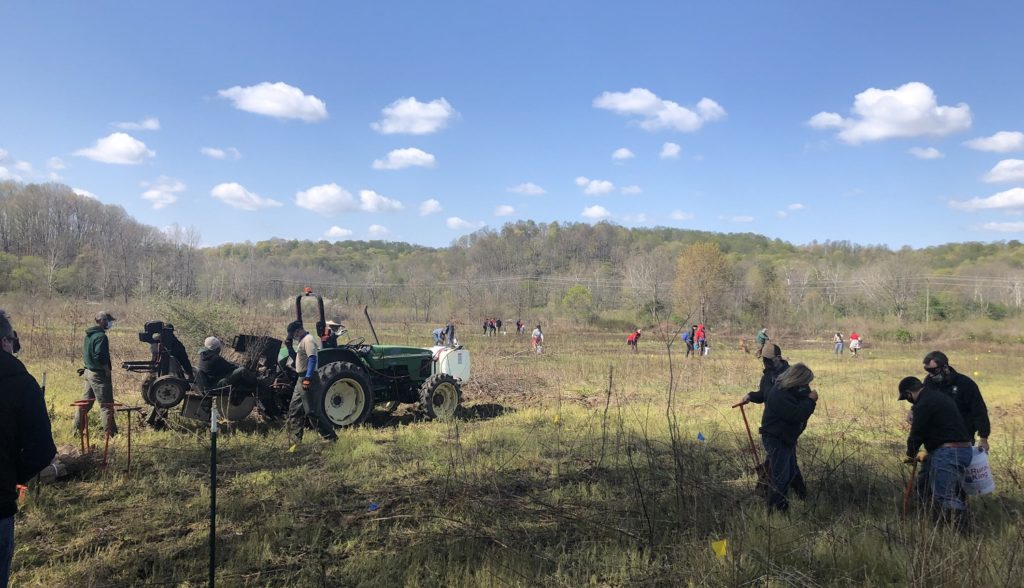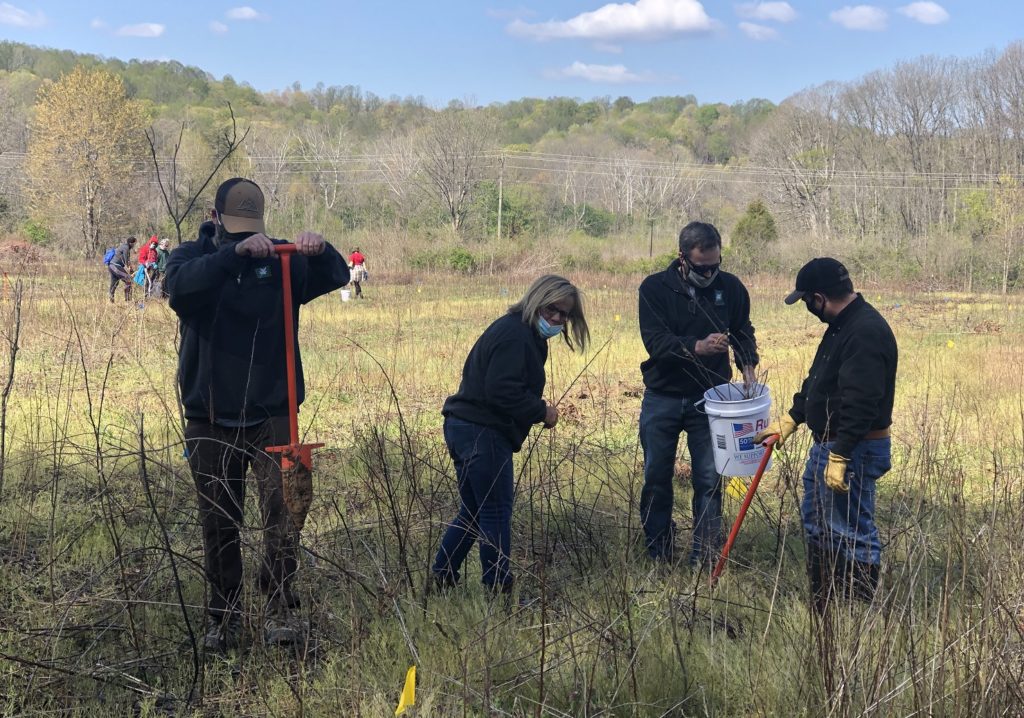5 Reasons to Support the Indiana Tree Project

On Earth Day, we partnered with the DNR Division of Forestry and volunteers from Clif Bar to plant more than 5,000 trees at Ravinia State Forest. This tree planting marked the third event we coordinated with Clif Bar in support of the Indiana Tree Project.
The day consisted of planting trees, followed by a group lunch and a guided forest hike with DNR Forestry representatives. They explained forest management and the benefits of planting young forests. We thought we would share five reasons why planting trees or donating to the cause is beneficial.
1. PLANTING IS A GREAT VOLUNTEER OPPORTUNITY
Donors and corporate partners who recognize the importance of planting trees in Indiana are making a difference today. Clif Bar provides the opportunity for its employees to volunteer together. That experience leaves its mark.
“We are proud to partner with the INRF and DNR as we work to plant trees in Indiana,” said Rebecca Leary, community project coordinator for Clif Bar Baking Company in Indianapolis. “We are constantly working to sustain our planet and community through partnerships like this.”
Corporations and individuals that assist in conservation efforts give back to their communities in big ways, leaving a legacy that will be treasured by future generations. Several volunteers at the tree planting on Earth Day noted that they will bring their families back to the planting site in twenty years and feel proud of the forest that they helped plant.

2. TREES IMPROVE AIR, SOIL AND WATER QUALITY
One of the top benefits of planting young trees is that they improve air, soil, and water quality. The watershed is improved when trees are planted, providing canopy over the soil. This stabilizes the soil and reduces sediment runoff. Trees add oxygen to the atmosphere while removing carbon.
“It is theorized that young, growing trees capture more carbon than aged forests,” said Donna Rogler, Indiana’s Project Learning Tree state coordinator. “Less than 10% of the forest cover in Indiana is in forests younger than 20 years old. More wildlife depend on young forest areas, including many songbirds whose populations are declining due to lack of habitat.”
3. YOUNG FORESTS PROVIDE WILDLIFE HABITAT
Increasing wildlife habitat is another benefit of large-scale tree planting. Approximately 85% of Indiana’s land was once covered by forests. The forest coverage provided ample space for wildlife to traverse forest floors and canopies without interruption from private land or urban development.
Today, Indiana’s forests cover approximately 18% of the land, leaving wildlife much less habitat to roam. Initiatives like the Indiana Tree Project can improve habitat access.
“As the trees we plant grow, they will benefit a broad range of game and nongame species by providing valuable cover and forage,” said Brad Schneck, assistant state forester. “Cover allows wildlife to escape predators, find safe nesting areas, and raise their young. Forage is increased when we plant trees, allowing wildlife to find food from mast producing trees like oak and hickory.”

4. PLANTING TREES MAINTAINS ECOSYSTEMS
Indiana’s forest composition is changing over time, and much of the oak is being replaced by shade-tolerant tree species that can grow in the forest understory, such as sugar maple and American beech. The trees planted as part of the Indiana Tree Project tend to be varieties of oak and sometimes black walnut. These trees provide food for wildlife, and oaks are the keystone hardwood tree in Indiana’s landscape.
“While there is currently an abundance of oak in the overstory of much of Indiana’s forestland, there is a lack of oak regeneration in the understory across the landscape,” Rogler said. “Without the oaks in our forests, the forest ecosystem would be dramatically different or may even cease to exist altogether.”
5. HEALTHY FORESTS MEAN MORE OUTDOOR OPPORTUNITIES
Healthy forests provide a place where people can enjoy and appreciate nature. Hoosier families will have more opportunities to explore forest lands as the young trees mature.
Recreational opportunities, such as new hunting, hiking and wildlife viewing areas will increase as more trees are planted. Outdoor recreationalists will have the opportunity to watch young forests grow. Generations from now, the work done today to increase Indiana’s forested lands will be the legacy we wish to leave.
“Tree planting is a win-win for everyone,” said John Seifert, state forester. “Reforesting will benefit both societal concerns about conservation and add habitat for all types of plant and animal life.”
We welcome organizations and individuals that wish to get involved. Consider contributing today to the Indiana Tree Project. With your donation you will receive an official tree certificate, including coordinates to the location where your tree will be planted.
Companies interested in sponsoring the Indiana Tree Project can contact us for more information.
